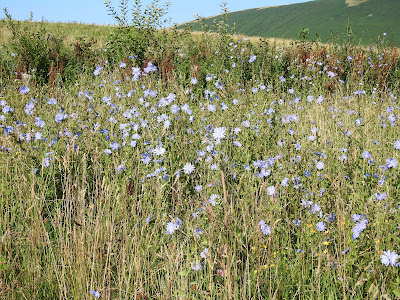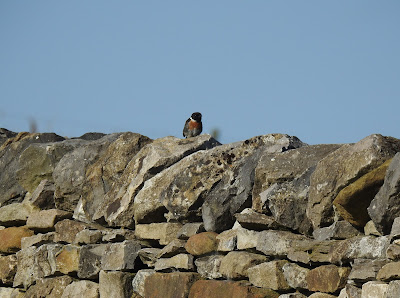I hope you all got the Jimi Hendrix reference in my Blog title, and Gail and I could have done with a bit of voodoo, when we made a slight return to Bowland this morning. I say 'slight return' because it wasn't quite as good for insects as when GT and I were there earlier in the week.
We wanted to get to the farm early enough to avoid the worst of the heat, whilst still making sure it was warm enough for plenty of insects to be on the wing. What we didn't count on, was the easterly breeze that we had this morning, which kept it a little cooler for us, well at first anyway, but it had obviously reduced the number of insects that were active.
hoverflies
We walked through the central wetland complex, along the pools by the lane, and up to the wader scrapes in the top field. The increase in the number of Meadow Pipits was obvious with birds flocking now, and we had at least 60 - 70 individuals.
A pair of Stonechats had at least two or three youngsters in tow, and at one stage they were all perched up on a wall with a couple of bright yellow juvenile Willow Warblers, and we had about ten Willow Warblers in total.
The scrapes look absolutely fantastic for some 'fresh' waders at the moment, but alas there was nothing on them other than a Grey Heron and some 50 or 60 moulting Mallards on one of the larger ones. The Belted Galloways are doing a fantastic job of keeping them open and the margins nice and poached.
Most of the ponds, pools and scrapes had blue damselflies on them. I say 'blue damselflies' because at a distance it is hard to tell Azure and Common Blue Damselfly apart, well it is for me anyway! However, habitat-wise the pools are more suitable for Common Blue Damselfly as they are more open, and some of the blue damselflies that I managed to have a good look at were definitely Common Blue.
How may were there, I'm not sure. On one pool I counted at least 60-70 Common Blue Damselflies, so if you were to extrapolate this to cover all the wetlands, there was probably in the region of at least 4 - 500 Common Blue Damselflies on all of the pools this morning. We only had one Blue-tailed Damselfly and a couple of Emerald Damselflies, and just one Emperor Dragonfly patrolling one of the pools.
I read recently that the International Panel on Climate Change has issued its sixth report, which warns that any further delay in global action to slow climate change and adapt to its impacts will miss a brief and rapidly closing window of opportunity to secure a liveable and sustainable future for all. Even with an increase of 1.5 degree C, species extinctions will be high, and above this many impacts of global warming will be irreversible. Will governments listen? Absolutely not, and I'm afraid that it is already probably too late!
On this date (12th August) in 2000, Gail and I were on our way to Belfast from Heysham. Seawatching from the deck, we recorded 71 Gannets, 5 Kittiwakes, 2 Fulmars, 86 Manx Shearwaters, 2 Great Skuas, 5 Razorbills, 14 Guillemots, 2 Shags and a Storm Petrel, and it made me think about the highly pathogenic H5N1 strain of avian influenza that some of our beleaguered seabird populations are suffering with at the moment.
The RSPB has reported that avian influenza has been confirmed on Grassholm, which supports the third largest colony of Northern Gannets in the world. Apparently, the outbreak on Grassholm is small, but of course it has the potential to escalate, but let's hope that as the birds disperse at the end of the breeding season, this will help to keep the number of casualties down. We can only hope!






No comments:
Post a Comment